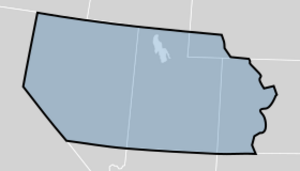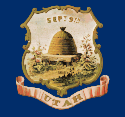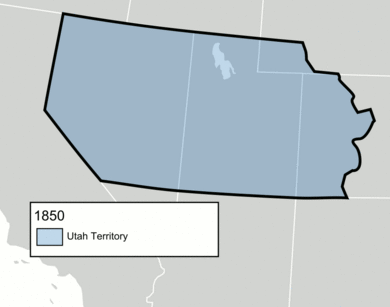Utah Territory facts for kids
Quick facts for kids Territory of Utah |
|||||||||
|---|---|---|---|---|---|---|---|---|---|
| Organized incorporated territory of the United States | |||||||||
| 1850–1896 | |||||||||
|
|
|||||||||
 The Utah Territory upon its creation, with modern state boundaries shown for reference |
|||||||||
| Capital |
|
||||||||
| Government | |||||||||
| • Type | Organized incorporated territory | ||||||||
| Governor | |||||||||
|
• 1851–58
|
Brigham Young | ||||||||
|
• 1858–61
|
Alfred Cumming | ||||||||
|
• 1875–80
|
George W. Emery | ||||||||
|
• 1880–86
|
Eli Houston Murray | ||||||||
|
• 1886–89, 1893–96
|
Caleb Walton West | ||||||||
| Legislature | Utah Territorial Assembly | ||||||||
| History | |||||||||
| 1849 | |||||||||
|
• Utah Organic Act
|
9 September 1850 | ||||||||
|
• Colorado Territory formed
|
February 28, 1861 | ||||||||
|
• Nevada Territory formed
|
March 2, 1861 | ||||||||
|
• Wyoming Territory formed
|
July 25, 1868 | ||||||||
| 4 January 1896 | |||||||||
|
|||||||||
The Territory of Utah was a part of the United States that existed for many years. It started on September 9, 1850. It became the State of Utah, the 45th state, on January 4, 1896. When it was first created, the Utah Territory was much larger than today's Utah. It included all of present-day Utah. It also had most of Nevada, a big part of Colorado, and a small corner of Wyoming.
Contents
History of the Utah Territory
How the Territory Began
The United States Congress created the Utah Territory in 1850. This happened on the same day that California became a state. It was also when the New Mexico Territory was formed. Creating the Utah Territory was part of a big agreement called the Compromise of 1850. This agreement tried to keep a balance of power between states that allowed slavery and those that did not.
Most of the land for the Utah Territory came from Mexico. The U.S. got this land after the Treaty of Guadalupe Hidalgo in 1848. A small part of the territory, near the Colorado River, was also included.
Early Settlers and Government
The creation of the Utah Territory happened partly because of a request from the Mormon pioneers. These settlers had arrived in the Salt Lake Valley in 1847. Their leader, Brigham Young, asked Congress to let them join the U.S. as the State of Deseret. They wanted their capital to be Salt Lake City.
The proposed State of Deseret would have been huge. It would have covered the entire Great Basin and the Colorado River area. This included parts of nine current U.S. states. The Mormon settlers had already written a state constitution in 1849. Deseret was acting as the main government in the Great Basin before the Utah Territory was officially created.
After the territory was formed, Brigham Young became its first governor. He started his role on February 3, 1851. In the first meeting of the territory's lawmakers, they decided to keep all the laws that the State of Deseret had already made. Brigham Young had a lot of power as governor. For example, in 1873, the territory's lawmakers gave him the only right to make whiskey.
Changes to the Territory's Size
Even though Mormons were the main group in the Salt Lake area, other settlers started moving to the western part of the territory. This happened especially after silver was found at the Comstock Lode in 1858. Because of this, the Nevada Territory was created in 1861 from the western part of Utah Territory.
Non-Mormon settlers also moved to the eastern part of the territory. This was during the Pikes Peak Gold Rush. Gold was discovered at Breckenridge in Utah Territory in 1859. In 1861, a large part of the eastern area of the territory became part of the new Colorado Territory.
Later, in 1869, the Utah Territory approved women's right to vote. This was an important step for equal rights.
Becoming a State
It took 46 years for the Utah Territory to become a state. It finally joined the U.S. as the State of Utah in 1896. This was much longer than other territories created after it. For example, the Nevada Territory became a state in just three years (1864). Colorado became a state in 1876.
Symbols of Utah
The Utah state coat of arms is on the state seal and state flag. The beehive was chosen as a symbol for the State of Deseret in 1848. It shows that the people of Utah are hard-working and careful with their resources. The sego lilies on each side of the beehive stand for peace.
Population Growth
| Historical population | ||
|---|---|---|
| Year | Pop. | ±% |
| 1850 | 11,380 | — |
| 1860 | 40,273 | +253.9% |
| 1870 | 86,336 | +114.4% |
| 1880 | 146,608 | +69.8% |
| 1890 | 210,779 | +43.8% |
| Source: 1850–1890 | ||
In 1850, there were 9 churches with regular services in the Utah Territory. Most of these were likely LDS churches. By the 1890 census, 25 counties in the Utah Territory reported their populations. Here's how some of them grew:
| 1890 Rank |
County | 1850 Population |
1890 Population |
|---|---|---|---|
| 1 | Salt Lake | 6,157 | 58,457 |
| 2 | Utah | 2,026 | 23,768 |
| 3 | Weber | 1,186 | 22,723 |
| 4 | Cache | – | 15,509 |
| 5 | Sanpete | 365 | 13,146 |
| 6 | Summit | – | 7,733 |
| 7 | Box Elder | – | 7,642 |
| 8 | Davis | 1,134 | 6,751 |
| 9 | Sevier | – | 6,199 |
| 10 | Juab | – | 5,582 |
| 11 | Emery | – | 5,076 |
| 12 | Millard | – | 4,033 |
| 13 | Washington | – | 4,009 |
| 14 | Tooele | 152 | 3,700 |
| 15 | Wasatch | – | 3,595 |
| 16 | Beaver | – | 3,340 |
| 17 | Piute | – | 2,842 |
| 18 | Uintah | – | 2,762 |
| 19 | Iron | 360 | 2,683 |
| 20 | Garfield | – | 2,457 |
| 21 | Morgan | – | 1,780 |
| 22 | Kane | – | 1,685 |
| 23 | Rich | – | 1,527 |
| 24 | Grand | – | 541 |
| 25 | San Juan | – | 365 |
| Indian reservations | 4,645 | – | |
| Utah Territory | 11,380 | 210,779 |
See Also
 In Spanish: Territorio de Utah para niños
In Spanish: Territorio de Utah para niños




